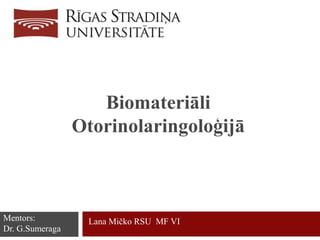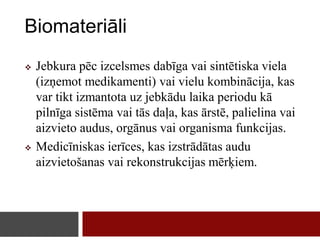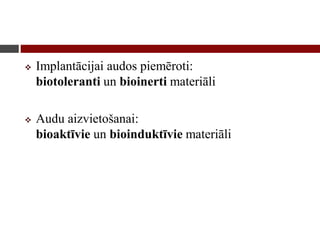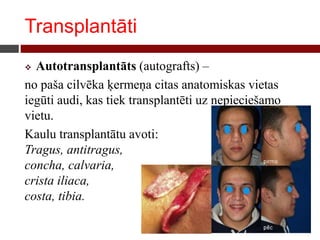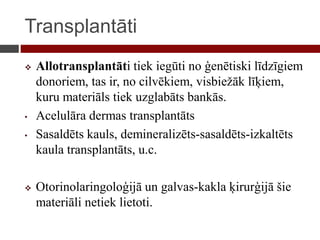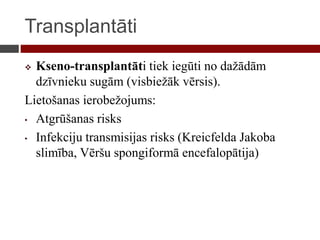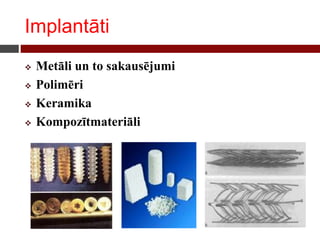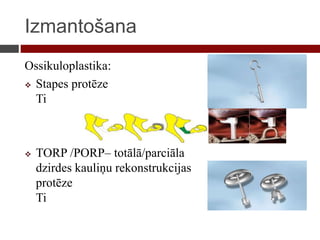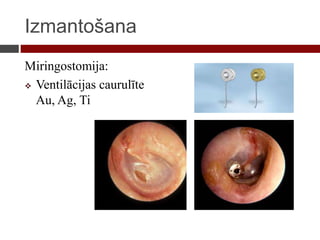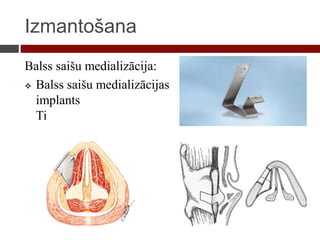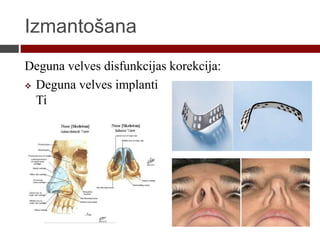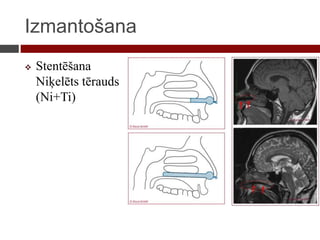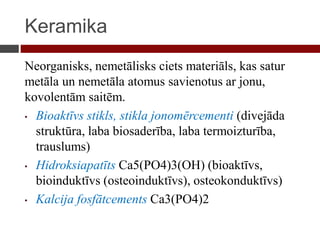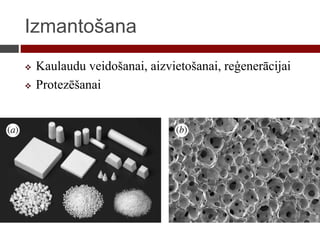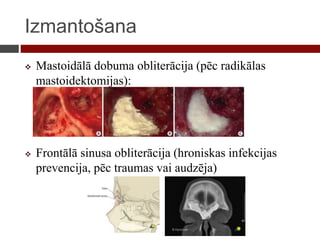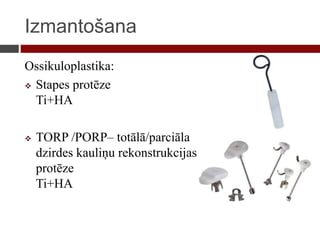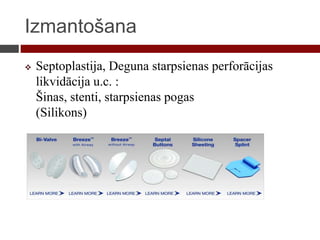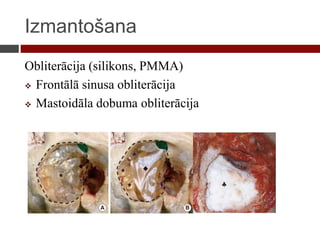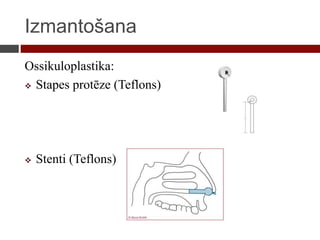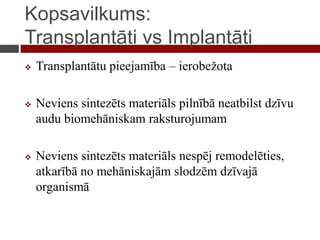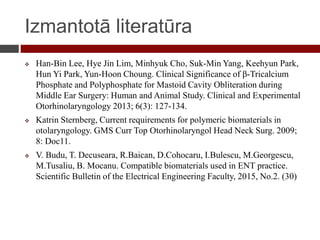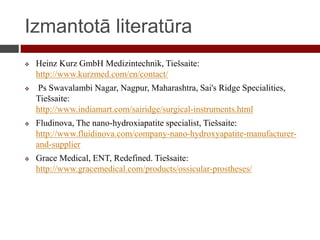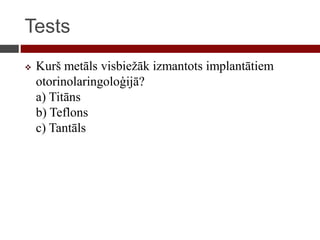BiomateriДЃli otorinolaringoloДЈijДЃ
- 1. BiomateriДЃli OtorinolaringoloДЈijДЃ Lana MiДЌko RSU MF VIMentors: Dr. G.Sumeraga
- 2. Biomateriāli  Jebkura pēc izcelsmes dabīga vai sintētiska viela (izņemot medikamenti) vai vielu kombinācija, kas var tikt izmantota uz jebkādu laika periodu kā pilnīga sistēma vai tās daļa, kas ārstē, palielina vai aizvieto audus, orgānus vai organisma funkcijas.  Medicīniskas ierīces, kas izstrādātas audu aizvietošanas vai rekonstrukcijas mērķiem.
- 3. Biomateriālu īpašības  Biosaderība – materiāla saderība ar apkārtējiem audiem, kad telpa starp materiālu un audiem ir dabiska, bez radītām izmaiņām – bez iekaisīgu un imunoloģisku reakciju izpausmēm.  Biomateriāli lokāli vai sistēmiski nav toksiski, netraucē audu šūnu normālu diferenciāciju, nav alergēns un imunogēns.
- 4. BiomateriДЃlu klasifikДЃcija пЃ¶ Biotoleranti materiДЃli netiek atgrЕ«sti, bet tiek atdalД«ti no apkДЃrtД“jiem audiem fibrozas kapsulas izveidoЕЎanДЃs rezultДЃtДЃ; пЃ¶ Bioinerti materiДЃli netiek atdalД«ti, tДЃpД“c pilnД«bДЃ kontaktД“ ar audiem bez novД“rotas bioloДЈiskas savstarpД“jas mijiedarbД«bas; пЃ¶ BioaktД«vi materiДЃli pateicoties savstarpД“jai mijiedarbД«bai ar audiem, veicina audu ieaugЕЎanu, kДЃ rezultДЃtДЃ materiДЃls tiek aizstДЃts ar jauniem audiem; пЃ¶ BioinduktД«vie materiДЃli inducД“ audu veidoЕЎanos ДЃrpus to dabД«gДЃs lokalizДЃcijas.
- 5. пЃ¶ ImplantДЃcijai audos piemД“roti: biotoleranti un bioinerti materiДЃli пЃ¶ Audu aizvietoЕЎanai: bioaktД«vie un bioinduktД«vie materiДЃli
- 6. Transplantāti  Autotransplantāts (autografts) – no paša cilvēka ķermeņa citas anatomiskas vietas iegūti audi, kas tiek transplantēti uz nepieciešamo vietu. Kaulu transplantātu avoti: Tragus, antitragus, concha, calvaria, crista iliaca, costa, tibia.
- 7. Transplantāti  Allotransplantāti tiek iegūti no ģenētiski līdzīgiem donoriem, tas ir, no cilvēkiem, visbiežāk līķiem, kuru materiāls tiek uzglabāts bankās. • Acelulāra dermas transplantāts • Sasaldēts kauls, demineralizēts-sasaldēts-izkaltēts kaula transplantāts, u.c.  Otorinolaringoloģijā un galvas-kakla ķirurģijā šie materiāli netiek lietoti.
- 8. Transplantāti  Kseno-transplantāti tiek iegūti no dažādām dzīvnieku sugām (visbiežāk vērsis). Lietošanas ierobežojums: • Atgrūšanas risks • Infekciju transmisijas risks (Kreicfelda Jakoba slimība, Vēršu spongiformā encefalopātija)
- 9. ImplantДЃti пЃ¶ MetДЃli un to sakausД“jumi пЃ¶ PolimД“ri пЃ¶ Keramika пЃ¶ KompozД«tmateriДЃli
- 10. Metāli un to sakausējumi • Titāns un tā sakausējumi (visplašāk pielietots, labākā biosaderība, viegls, rezistents pret koroziju, relatīvi mīksts, viegli deformējams) • Zelts, sudrabs, tantāls • Nerūsējošais tērauds (Ni jonu izdale→ Ni hipersensitivitāte, relatīvi trausls, raksturīgs izteikts Me «nogurums»)
- 11. Izmantošana Ossikuloplastika:  Stapes protēze Ti  TORP /PORP– totālā/parciāla dzirdes kauliņu rekonstrukcijas protēze Ti
- 13. IzmantoЕЎana Balss saiЕЎu medializДЃcija: пЃ¶ Balss saiЕЎu medializДЃcijas implants Ti
- 14. IzmantoЕЎana Deguna velves disfunkcijas korekcija: пЃ¶ Deguna velves implanti Ti
- 16. Keramika Neorganisks, nemetālisks ciets materiāls, kas satur metāla un nemetāla atomus savienotus ar jonu, kovolentām saitēm. • Bioaktīvs stikls, stikla jonomērcementi (divejāda struktūra, laba biosaderība, laba termoizturība, trauslums) • Hidroksiapatīts Ca5(PO4)3(OH) (bioaktīvs, bioinduktīvs (osteoinduktīvs), osteokonduktīvs) • Kalcija fosfātcements Ca3(PO4)2
- 17. IzmantoЕЎana пЃ¶ Kaulaudu veidoЕЎanai, aizvietoЕЎanai, reДЈenerДЃcijai пЃ¶ ProtezД“ЕЎanai
- 18. IzmantoЕЎana пЃ¶ MastoidДЃlДЃ dobuma obliterДЃcija (pД“c radikДЃlas mastoidektomijas): пЃ¶ FrontДЃlДЃ sinusa obliterДЃcija (hroniskas infekcijas prevencija, pД“c traumas vai audzД“ja)
- 19. Izmantošana Ossikuloplastika:  Stapes protēze Ti+HA  TORP /PORP– totālā/parciāla dzirdes kauliņu rekonstrukcijas protēze Ti+HA
- 20. PolimД“ri пЃ¶ PoliuretДЃns пЃ¶ PolietilД“ni пЃ¶ Poliesteri пЃ¶ Silikoni пЃ¶ PolimetilmetakrilДЃts (PMMA) пЃ¶ PolitetrafluoretilД“ns (PTFA=Teflons)
- 21. IzmantoЕЎana пЃ¶ Septoplastija, Deguna starpsienas perforДЃcijas likvidДЃcija u.c. : Е inas, stenti, starpsienas pogas (Silikons)
- 22. IzmantoЕЎana ObliterДЃcija (silikons, PMMA) пЃ¶ FrontДЃlДЃ sinusa obliterДЃcija пЃ¶ MastoidДЃla dobuma obliterДЃcija
- 23. IzmantoЕЎana Ossikuloplastika: пЃ¶ Stapes protД“ze (Teflons) пЃ¶ Stenti (Teflons)
- 24. IzmantoЕЎana Permamenti injicД“jami filleri (silikons, PMMA) пЃ¶ Balss saiЕЎu medializДЃcija пЃ¶ NeД·irurДЈiska rinoplastija пЃ¶ Citas lokalizДЃcijas audu augmentДЃcija
- 25. Kopsavilkums: Transplantāti vs Implantāti  Transplantātu pieejamība – ierobežota  Neviens sintezēts materiāls pilnībā neatbilst dzīvu audu biomehāniskam raksturojumam  Neviens sintezēts materiāls nespēj remodelēties, atkarībā no mehāniskajām slodzēm dzīvajā organismā
- 26. Izmantotā literatūra  Malard O1, Espitalier F, Bordure P, Daculsi G, Weiss P, Corre P. Biomaterials for tissue reconstruction and bone substitution of the ear, nose and throat, face and neck. Expert Rev Med Devices. 2007 Sep;4(5):729- 39.  Rondini-Gilli E, Grayeli AB, Borges Crosara PF et al. Ossiculoplasty with total hydroxiapatite prostheses anatomical and functional outcomes. Otol. Neurotol. 24940, 543-547 (2003)  Yung MW. The use of hydroxyapatite granules in mastoid obliteration. Clin. Otolaryngol. Allied Sci. 21(6), 480-484 (1996)  Byron J. Bailey, Jonas T. Johnson. Head and Neck Surgery – Otolaryngology. Grafts and Implants in Facial, Head, and Neck Surgery. Fourth edition.  Treace HT. Biomaterials in ossiculoplasty and historu of develompent of prostheses for ossiculoplasty. Otolaryngol. Clin. North. Am. 27(4), 655- 662 (1994)
- 27. IzmantotДЃ literatЕ«ra пЃ¶ Han-Bin Lee, Hye Jin Lim, Minhyuk Cho, Suk-Min Yang, Keehyun Park, Hun Yi Park, Yun-Hoon Choung. Clinical Significance of ОІ-Tricalcium Phosphate and Polyphosphate for Mastoid Cavity Obliteration during Middle Ear Surgery: Human and Animal Study. Clinical and Experimental Otorhinolaryngology 2013; 6(3): 127-134. пЃ¶ Katrin Sternberg, Current requirements for polymeric biomaterials in otolaryngology. GMS Curr Top Otorhinolaryngol Head Neck Surg. 2009; 8: Doc11. пЃ¶ V. Budu, T. Decuseara, R.Baican, D.Cohocaru, I.Bulescu, M.Georgescu, M.Tusaliu, B. Mocanu. Compatible biomaterials used in ENT practice. Scientific Bulletin of the Electrical Engineering Faculty, 2015, No.2. (30)
- 28. IzmantotДЃ literatЕ«ra пЃ¶ Heinz Kurz GmbH Medizintechnik, TieЕЎsaite: http://www.kurzmed.com/en/contact/ пЃ¶ Ps Swavalambi Nagar, Nagpur, Maharashtra, Sai's Ridge Specialities, TieЕЎsaite: http://www.indiamart.com/sairidge/surgical-instruments.html пЃ¶ Fludinova, The nano-hydroxiapatite specialist, TieЕЎsaite: http://www.fluidinova.com/company-nano-hydroxyapatite-manufacturer- and-supplier пЃ¶ Grace Medical, ENT, Redefined. TieЕЎsaite: http://www.gracemedical.com/products/ossicular-prostheses/
- 29. Tests пЃ¶ BioaktД«vi materiДЃli: a) tiek atdalД«ti no apkДЃrtД“jiem audiem fibrozas kapsulas izveidoЕЎanДЃs rezultДЃtДЃ; b) netiek atdalД«ti, tДЃpД“c pilnД«bДЃ kontaktД“ ar audiem bez novД“rotas bioloДЈiskas savstarpД“jas mijiedarbД«bas; c) pateicoties savstarpД“jai mijiedarbД«bai ar audiem, veicina audu ieaugЕЎanu, kДЃ rezultДЃtДЃ materiДЃls tiek aizstДЃts ar jauniem audiem;
- 30. Tests пЃ¶ KurЕЎ transplantДЃtu veids ir zelta standarts transplantoloДЈijДЃ: a) autotransplantДЃti b) allotransplantДЃti c) ksenotransplantДЃti
- 31. Tests пЃ¶ KurЕЎ metДЃls visbieЕѕДЃk izmantots implantДЃtiem otorinolaringoloДЈijДЃ? a) TitДЃns b) Teflons c) TantДЃls
Editor's Notes
- #4: Pirms materiДЃla lietoЕЎanas tiek testД“ta arД« materiДЃla mutagenitДЃte un kancerogenitДЃte. Balstoties uz audu reakciju pret biomateriДЃlu, materiДЃli tiek klasificД“ti:
- #5: AtbilstoЕЎi biomateriДЃlu mijiedarbД«bai ar aufiem izЕЎД·ir: 1) Biotoleranti materiДЃli netiek atgrЕ«sti, bet tiek atdalД«ti no apkДЃrtД“jiem audiem fibrozas kapsulas izveidoЕЎanДЃs rezultДЃtДЃ 2) Bioinerti materiДЃli netiek atdalД«ti, tДЃpД“c pilnД«bДЃ kontaktД“ ar audiem bez novД“rotas bioloДЈiskas savstarpД“jas mijiedarbД«bas; 3) BioaktД«vi materiДЃli pateicoties savstarpД“jai mijiedarbД«bai ar audiem, veicina audu (kaulu) ieaugЕЎanu, kДЃ rezultДЃtДЃ materiДЃls tiek aizstДЃts (ar kaulaudiem); 4) BioinduktД«vie materiДЃli inducД“ audu veidoЕЎanos ДЃrpus to dabД«gДЃs lokalizДЃcijas (p: ektopiskДЃ kaula veidoЕЎanДЃs)
- #6: Tas nozД«mД“, ka biotoleranti un bioinerti materiДЃli ir piemД“roti implantДЃcijai (kaulДЃ), bet audu aizvietoЕЎanai tiek lietoti bioaktД«vie un bioinduktД«vie materiДЃli. [15]
- #7: Zelta standarts transplantoloДЈijДЃ. Kaulu transplantДЃti tiek izmantoti: kaulaudu augmentДЃcijДЃ, kaulu dobumu obliterДЃcijДЃs kДЃ arД« kaulu defektu likvidДЃcijai, kas raduЕЎies traumas, infekcijas vai audzД“ja ekstirpДЃcijas gadД«jumДЃ.
- #8: TДЃtad materiДЃls pД“c iegЕ«ЕЎanas tiek daЕѕДЃdos veidos apstrДЃdДЃts, lai samazinДЃtu iespД“jamДЃs imЕ«nreakcijas, kas novestu pie materiДЃla atgrЕ«ЕЎanas, infekciju transmisijas riskus. Ir bijuЕЎi daЕѕДЃdi mД“ДЈinДЃjumi lietot ЕЎo transplantДЃtu veidu, piemД“ram lietojot acelulДЃrДЃs dermas transplantДЃtu deguna starpsienas perforДЃcijas likvidДЃcijai, taДЌu pietiekami labi rezultДЃti netiek sasniegti, tДЃpД“c imunoloДЈisko un infekciozo aspektu dД“Дј ЕЎo transplantДЃtu lietoЕЎana ir limitД“ta un otorinolaringoloДЈijДЃ kДЃ arД« galvas un kakla Д·irurДЈijДЃ ЕЎie materiДЃli netiek lietoti.
- #11: Me pieder pie visvecДЃkajiem, vissenДЃk izmantojamiem biomateriДЃliem. Д»oti daЕѕДЃdi Me un to sakausД“jumu varianti tiek lietoti implantДЃtu izgatavoЕЎanai, taДЌu bieЕѕДЃk izmantojamie Me otorinolaringoloДЈijДЃ lietojamiem biomateriДЃliem ir: Ti, TД“rauds un tantДЃls.
- #12: Stapes protēze (stapedioplastikai) (no titāna- tiek uzskatīts par labāko materiālu šai protēzei) (pieejami arī varianti no teflona, hidroksiapatīta, polietilēna) TORP /PORP– (timpanoplastikai) totālā/parciāla dzirdes kauliņu rekonstrukcijas protēze Ti. Septal button (starpsienas poga) – pamatā tiek izgatavoti no cita materiāla, bet sastop arī no Ti izgatavotus.
- #14: Balss saišu medializācijai, ko pielieto unilaterāla n.laryngeus inferior paralīzes gadījumā paralizētās balss saites novirzīšana mediāli – lai ↓gaisa noplūdi, balss intensitāti ↑, lieto Ti implantu.
- #15: Deguna velvju disfunkcijas gadījumā, kad pie ieelpas tiek sakļautas nāsis – attīstās respiratorā nepietiekamība. Deguna velvju dilatācijai lieto implantus, kas tiek fiksēti pie augšējā laterālā skrimšļa.
- #17: Keramika ir neorganisks, nemetālisks ciets materiāls, kas satur metāla un nemetāla atomus savienotus ar jonu, kovolentām saitēm. Ir ļoti plašs keramikas materiālu klāsts no kuriem visbiežāk izmantojamie ir: bioaktīvs stikls, stikla jonomērcementi, hidroksiamatīta kristāli, kalcija fosfāts. Bioaktīvs stikls, stikla jonomērcementi – tam divejāda struktūra (režģa, amorfa), ir trausli materiāli, tāpēc to izmantošana ir limitēta vietās, kuras ir pakļautas slodzēm, piemēram, ossikuloplastikai tie nav piemēroti) Jau citas keramikas formas ir HA un CP, kuru sastāvā ir elementi ir kaula pamatsubstances (Ca, P). HA ir bioaktīvs un bioinduktīvs (osteoinduktīvs- inducē osteoģenēzi), osteokonduktīvs (nodrošina osteoģenēzi uz virsmas) materiāls tāpēc plaši lietojami kaulaudu aizvietošanai un reģenerācijai kā arī citu implantātu pārklāšanai lai veicinātu tā osteointegrāciju. Kalcija fosfāta ķīmija ir līdzīga, jo tas noteiktos apstākļos veido Hidroksiapatītu.
- #19: Mastoidālā dobuma obliterācija, ko iesaka pēc radikālas mastoidektomijas (destruktīva holesteatoma vai hronisks otīts), lai samazinātu ↓ izdalījumu daudzums, sekmē labāku dzirdes funkciju, ↓ holestestomas recidīva risku. Obliteration using hydroxyapatite is recommended only over non-cholesteatomatous sites because of the risk of residual disease and the difficulty re-exploring these cases. Frontālā sinusa obliterācija (hroniskas infekcijas prevencija, pēc traumas vai audzēja)
- #21: PolimД“ri ir Дјoti plaЕЎi izplatД«ts materiДЃls, jo to mehДЃniskДЃs Д«paЕЎД«bas ir salД«dzinoЕЎi viegli mainДЃmas un pielДЃgojamas nepiecieЕЎamajai izmantoЕЎanai. Mainot gan to strukturДЃlo, gan Д·Д«misko sastДЃvu iespД“jams iegЕ«t Дјoti plaЕЎu materiДЃlu klДЃstu ar daЕѕДЃdДЃm Д«paЕЎД«bu kombinДЃcijДЃm.
- #22: Deguna silikona ЕЎinas (lieto pД“c septoplastijas)
- #23: AttД“los redzami daЕѕДЃda izmД“ra izmantojamie silikona bloki dobumu obliterДЃcijai
- #25: + jebkura cita audu augmentДЃcija
